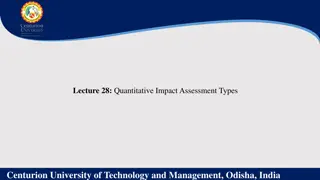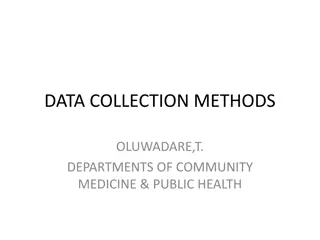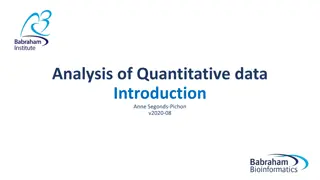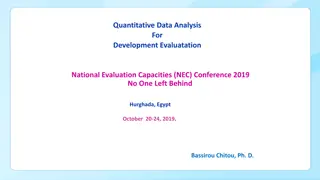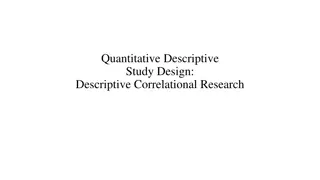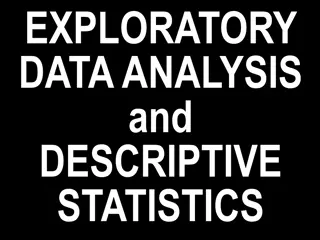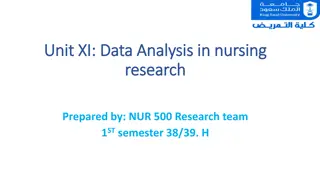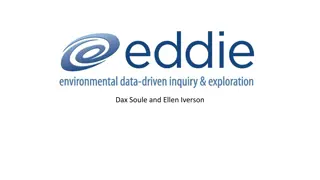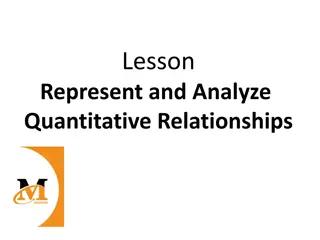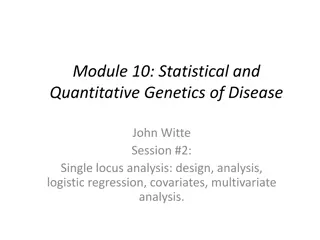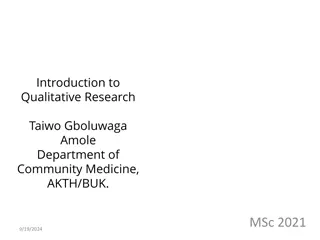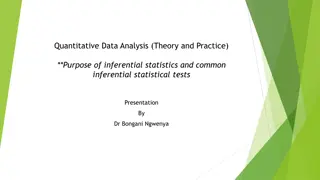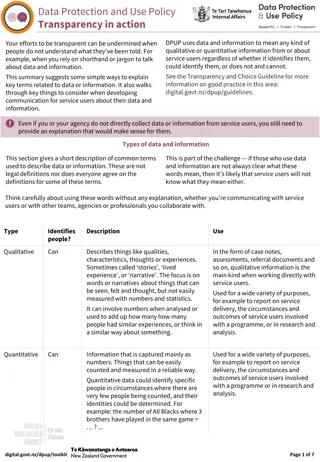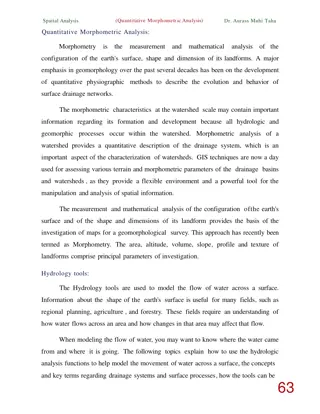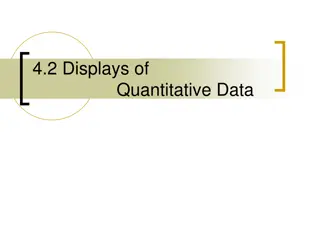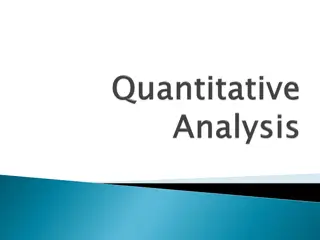Analyzing Qualitative and Quantitative Data
The findings from qualitative and quantitative data analysis. Learn how to apply analysis steps, compare platforms, and interpret results.
0 views • 33 slides
A Primer for Designing Quantitative Research Studies
This primer introduces the processes involved in designing a quantitative study, focusing on conceptualization and design basics. It emphasizes the importance of training, coursework, and experience for conducting high-quality scholarly research. The content covers the purpose of the primer, variati
5 views • 29 slides
Overview of Data Science: Uncovering Insights from Data
Data science is a multi-disciplinary field that utilizes scientific methods to extract knowledge from various types of data. Data scientists play a crucial role in uncovering valuable insights for organizations by mastering the full data science life cycle and possessing key skills such as curiosity
5 views • 46 slides
Overview of Research Process and Quantitative Research Phases
The research process involves steps like identifying, locating, assessing, and analyzing the research question to find answers. It includes quantitative and qualitative approaches, with specific phases like conceptual, design, empirical, analytic, and disseminating phases in quantitative research. E
9 views • 27 slides
Understanding Quantitative and Qualitative Research Methods
Exploring the differences between quantitative and qualitative research methods, this content delves into the importance of qualitative research, various methodologies such as focus groups and interviews, data collection, research ethics, and analysis techniques. It also covers the elements of the r
4 views • 43 slides
Understanding Quantitative Impact Assessment and Evaluation Methods
Quantitative impact assessments play a crucial role in measuring the effects of interventions or programs. Key types include output-based and outcome-based indicators, impact evaluations, cost-effectiveness analysis, econometric analysis, and the use of surveys and questionnaires. These methods help
0 views • 4 slides
Analyzing Two-Variable Data in Statistics and Probability
This content delves into analyzing relationships between two quantitative variables in statistics and probability, focusing on distinguishing between explanatory and response variables, creating scatterplots, and interpreting the strength and form of relationships displayed. It emphasizes the import
0 views • 14 slides
Understanding Boxplots and Identifying Outliers in Quantitative Data Analysis
Learn how to interpret boxplots, identify outliers using the 1.5 x IQR rule, and compare distributions of quantitative data. Explore examples like Barry Bonds' home run records and tablet thickness measurements to enhance your statistical analysis skills.
0 views • 21 slides
Unlocking the Power of Big Data in Teaching: Project EDDIE Workshop Insights
Delve into the impactful world of Project EDDIE, an initiative promoting data-driven inquiry in STEM education. Explore the benefits of teaching with big data, understand quantitative reasoning, and discover the objectives of EDDIE workshops. Experience the 5E model and enhance your approach to deve
0 views • 9 slides
Understanding Dotplots for Displaying Quantitative Data
Learn how to create and interpret dotplots for quantitative data visualization. This lesson covers making dotplots, describing distribution shapes, and comparing data sets. Explore the simplicity and effectiveness of dotplots in representing numerical information. Gain insights into analyzing dotplo
0 views • 14 slides
Understanding Data Collection Methods in Health Sciences
Data collection in health sciences involves gathering raw facts systematically to answer research questions and evaluate outcomes. This includes selecting appropriate methods based on the nature of the enquiry, availability of resources, and required precision. Quantitative data collection focuses o
0 views • 28 slides
Project Risk Management Fundamentals: A Comprehensive Overview
Project risk management involves minimizing potential risks and maximizing opportunities through processes such as risk management planning, risk identification, qualitative and quantitative risk analysis, risk response planning, and risk monitoring and control. Quantitative risk analysis assesses t
0 views • 41 slides
Understanding Statistical Inference and Significance in Quantitative Data Analysis
Explore the key concepts of statistical inference, null hypothesis, error types, and the signal-to-noise ratio in quantitative data analysis. Learn about choosing the correct statistical test based on data assumptions, such as parametric tests with specific requirements and non-parametric tests. Gai
0 views • 12 slides
“Quantitative Data Analysis for Development - NEC Conference 2019 Overview”
Explore the key modules of the National Evaluation Capacities Conference 2019 focusing on quantitative data analysis for development. Covering topics such as basic concepts, summary statistics, bivariate analysis, hypothesis testing, data visualization, and the effective use of dummy tables in evalu
0 views • 25 slides
Introduction to Quantitative Reasoning using Spreadsheets
Explore the use of technology and modeling cycle in quantitative reasoning. Learn to read from spreadsheets, interpret data, analyze simple formulae and graphs, estimate quantities, and create mathematical models to solve real-world problems effectively. Leveraging resources and tools integral to ma
1 views • 38 slides
Contrasting Qualitative and Quantitative Traits in Genetics
Genetic traits in organisms can be qualitative or quantitative, with qualitative traits controlled by single genes and showing distinct variations, while quantitative traits are influenced by multiple genes and environmental factors, resulting in continuous variations. Qualitative genetics focuses o
0 views • 13 slides
Understanding Quantitative Research Design in Social Science
This content covers various aspects of quantitative research design, including descriptive and correlational studies, research design blueprint, robust research design considerations, and different types of research approaches. It emphasizes the characteristics, techniques, and terminologies associa
0 views • 24 slides
Understanding Histograms in Displaying Quantitative Data
Learn how to create and interpret histograms in displaying quantitative data. This lesson covers making histograms, interpreting distributions, and comparing data sets. Understand the importance of grouping data values and creating equal-width intervals for a clearer visualization. Explore the proce
10 views • 16 slides
Understanding Quantitative Analysis for Decision Making in Management
Quantitative analysis is a crucial scientific approach for managerial decision-making, involving data manipulation to derive valuable information. This method encompasses problem definition, model development, and acquiring input data. Mathematical models, variables, and parameters play key roles in
0 views • 11 slides
Qualitative vs. Quantitative Approaches in Health Research
Exploring the different methodologies, paradigms, and methods used in health research, this content highlights the distinction between qualitative and quantitative designs. It covers research questions, aims, objectives, hypotheses, and various quantitative approaches such as experimental and observ
1 views • 28 slides
Understanding Quantitative Genetics Principles in Animal Breeding
Quantitative genetics focuses on the inheritance of characteristics based on degree rather than kind, compared to qualitative genetics. It involves polygenes controlling quantitative traits, which exhibit continuous variation and can be measured using metric units. Qualitative traits, on the other h
0 views • 22 slides
Understanding Quantitative Research in Social Studies: A Comprehensive Overview
An in-depth exploration of quantitative research methods in social studies, covering concepts, data analysis, survey techniques, causality identification, and setting up research projects. Emphasizes the importance of grasping strengths, pitfalls, and key points in quantitative research and understa
0 views • 51 slides
Exploratory Data Analysis and Descriptive Statistics in Statistical Analysis
Exploratory Data Analysis involves understanding data characteristics through visualization techniques like bar graphs, pie charts for qualitative data and histograms, scatterplots for quantitative data. It includes calculating mean, median for center, range, standard deviation for spread, and ident
0 views • 7 slides
Understanding Data Analysis in Nursing Research
Data analysis in nursing research involves rendering individual data points into meaningful information, leading to knowledge generation. The process includes qualitative and quantitative analysis to organize and interpret data effectively. Techniques such as data reduction, data display, and conclu
2 views • 26 slides
Project EDDIE: Enhancing Student Quantitative Reasoning with Large Datasets
Project EDDIE focuses on improving student quantitative reasoning through inquiry-driven exploration of complex datasets. The project aims to support instructors in guiding students to enhance their understanding of scientific concepts and quantitative skills. With a commitment to community and lear
0 views • 6 slides
Understanding IBM SPSS for Statistical Analysis
IBM SPSS, formerly known as Statistical Package for the Social Sciences, is a powerful software package for statistical analysis used by researchers across various industries. Developed in the late 1960s, SPSS offers features for data management, statistical analysis, and data documentation. It simp
1 views • 13 slides
Understanding and Representing Quantitative Relationships
Explore how to represent and analyze quantitative relationships using graphs, tables, and equations. Practice with unit rates, plotting points in a coordinate plane, and understanding independent and dependent variables. Develop skills in creating equations, tables, and graphs to model relationships
0 views • 120 slides
Statistical and Quantitative Genetics of Disease
This session covers single locus analysis in statistical and quantitative genetics, focusing on design, analysis, logistic regression, covariates, and multivariate analysis. It discusses approaches for analyzing DNA on cases and controls, modeling, and adjusting for covariates. The association analy
0 views • 36 slides
Understanding Research Methods in Public Health
Exploring the nuances of qualitative and quantitative research methods in the context of public health, this content delves into how each approach offers unique insights and perspectives. It discusses the importance of qualitative research in uncovering underlying factors influencing health, interpr
0 views • 77 slides
Understanding Quantitative Analysis in Chemistry
Quantitative analysis in chemistry involves determining the concentration or mass of a compound in a sample, which is crucial for various applications such as measuring intoxication levels, assessing health risks, and determining the benefits or harm of substances. This course, taught by experienced
0 views • 16 slides
Understanding Quantitative Data Analysis in Research
In quantitative data analysis for research, the type of research question influences the statistical methods used. Descriptive questions describe a situation without hypothesis testing. Comparative questions compare variables to assess differences, using tests like t-test and ANOVA. Relational quest
0 views • 31 slides
Understanding Data and Information Types in DPUP Policy
DPUP's Data Protection and Use Policy emphasizes transparency in utilizing both qualitative and quantitative data to describe service users. The provided guidelines stress the importance of clear communication to ensure users comprehend the terminology and concepts related to their data and informat
0 views • 7 slides
Quantitative Morphometric Analysis in Geomorphology
Quantitative morphometric analysis in geomorphology focuses on measuring and mathematically analyzing the earth's surface configuration and landform dimensions. It involves using GIS techniques to assess terrain parameters and drainage systems, providing valuable insights into watershed characterist
0 views • 8 slides
Visualizing Quantitative Data Analysis
Explore various methods for displaying quantitative data analysis, including stem-and-leaf plots, box-and-whisker plots, dot plots, frequency tables, and histograms. Learn how to interpret these visual representations to gain insights into the distribution and characteristics of your data.
0 views • 11 slides
Principles of Data Analysis and ICT in Postgraduate Studies at University of Nigeria
This lecture at the University of Nigeria, Nsukka, School of Postgraduate Studies focuses on the importance of ICT in data analysis, different data collection strategies, and the significance of using qualitative and quantitative data. The goals include creating awareness about ICT's role, refreshin
0 views • 22 slides
Exploring Photosynthesis: A Quantitative Analysis Vignette for Biology Students
Delve into the world of photosynthesis with an engaging vignette designed to enhance quantitative literacy skills in biology students. The focus is on understanding the relationship between carbon fixation, plant biomass, and forests as carbon sinks. Through interactive learning goals and objectives
0 views • 24 slides
Understanding Research Data Collection and Importance
Research data is essential for validating original research findings and can take various forms, both digital and non-digital. It plays a crucial role in improving lives, making informed decisions, solving problems, and ensuring strategic approaches. Data can be qualitative or quantitative, with qua
0 views • 41 slides
Quantitative Research Framework for Historical Disciplines
Scholarly communities in historical disciplines are combining quantitative and qualitative methods to study phenomena that change over time. The proposed general methodological reflection aims to enhance research in historical linguistics through quantitatively driven models and claims. Quantitative
0 views • 18 slides
Understanding UV-Visible Spectrophotometry for Quantitative Analysis
Spectrometry in quantitative analysis involves determining substance concentration through spectrophotometry. UV-Visible Spectrophotometry measures light absorption in the UV or visible region using the Beer-Lambert Law, relating absorbance to substance concentration. The electromagnetic spectrum en
0 views • 15 slides
Understanding the Differences Between Qualitative and Quantitative Research Methods
Qualitative research aims to understand social phenomena, while quantitative research tests hypotheses and focuses on cause and effect. Mixed methods combine both approaches for a stronger analysis. Researchers play different roles and use distinct methods and analysis techniques in each type of res
0 views • 22 slides





